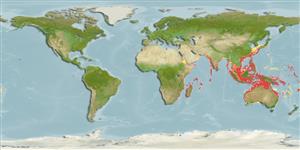Common names from other countries
Classification / Names / Names
Namen | Synonyme | Catalog of Fishes (gen., sp.) | ITIS | CoL | WoRMS
Environment: milieu / climate zone / depth range / distribution range
Ökologie
Riff-verbunden; tiefenbereich 10 - 100 m (Ref. 349). Tropical
Indo-West Pacific: including the Persian Gulf, to Melanesia; north to Japan and south to Queensland.
Length at first maturity / Size / Gewicht / Alter
Maturity: Lm ? range ? - ? cm Max length : 9.5 cm SHL Männchen/unbestimmt; (Ref. 349); common length : 6.0 cm SHL Männchen/unbestimmt; (Ref. 349)
Locally consumed by fishermen and used for shellcraft. Commonly trawled offshore in the tropical West Pacific (Ref. 349). Found offshore (Ref. 799). In general, members of the family Personidae are carnivores (Ref. 67623). A specialist feeder on chaetopterid polychaetes (Ref. 128693).
Life cycle and mating behavior
Geschlechtsreife | Fortpflanzung | Ablaichen | Eier | Fecundity | Larven
Members of the order Neotaenioglossa are mostly gonochoric and broadcast spawners. Life cycle: Embryos develop into planktonic trocophore larvae and later into juvenile veligers before becoming fully grown adults.
Poutiers, J.M. 1998. (Ref. 349)
IUCN Rote Liste Status (Ref. 130435)
CITES Status (Ref. 108899)
Not Evaluated
Not Evaluated
Bedrohung für Menschen
Harmless
Nutzung durch Menschen
| FishSource |
Tools
Mehr Information
Alter/GrößeWachstumLänge-GewichtLänge-LängeMorphologieLarvenDichte
Internet Quellen
Estimates based on models
Preferred temperature
(Ref.
115969): 24.3 - 29, mean 28 (based on 1344 cells).
Verwundbarkeit
Low vulnerability (10 of 100).
Preiskategorie
Unknown.
